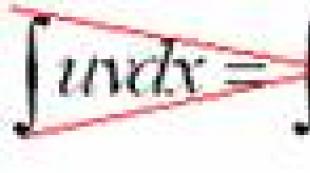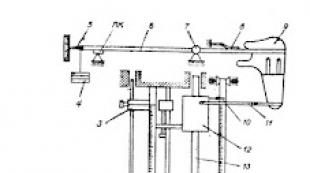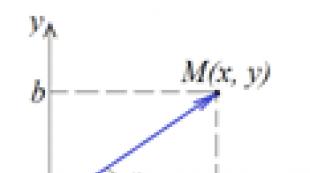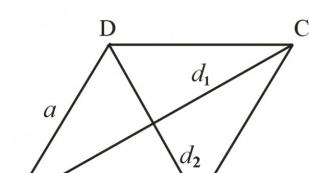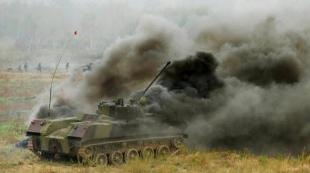Definition of the unit of measurement of magnetic flux. Magnetic induction flux. Innovations from an American developer
Using lines of force, you can not only show the direction of the magnetic field, but also characterize the magnitude of its induction.
We agreed to draw the field lines in such a way that through 1 cm² of the area, perpendicular to the induction vector at a certain point, there would pass a number of lines equal to the field induction at this point.
In the place where the field induction is greater, the field lines will be denser. And, conversely, where the field induction is less, the field lines are less frequent.
A magnetic field with the same induction at all points is called a uniform field. Graphically, a uniform magnetic field is depicted by lines of force, which are equally spaced from each other
An example of a uniform field is the field inside a long solenoid, as well as the field between closely spaced parallel flat pole pieces of an electromagnet.
The product of the induction of the magnetic field penetrating a given circuit by the area of the circuit is called magnetic flux, magnetic induction, or simply magnetic flux.
The English physicist Faraday gave it a definition and studied its properties. He discovered that this concept allows a deeper consideration of the unified nature of magnetic and electrical phenomena.
Denoting the magnetic flux with the letter Ф, the contour area S and the angle between the direction of the induction vector B and the normal n to the contour area α, we can write the following equality:
Ф = В S cos α.
Magnetic flux is a scalar quantity.
Since the density of the lines of force of an arbitrary magnetic field is equal to its induction, the magnetic flux is equal to the entire number of lines of force that penetrate a given circuit.
As the field changes, the magnetic flux that permeates the circuit also changes: when the field strengthens, it increases, and when it weakens, it decreases.
A unit of magnetic flux in is taken to be the flux that penetrates an area of 1 m², located in a uniform magnetic field, with an induction of 1 Wb/m², and located perpendicular to the induction vector. Such a unit is called a weber:
1 Wb = 1 Wb/m² ˖ 1 m².
A changing magnetic flux generates an electric field with closed lines of force (vortex electric field). Such a field manifests itself in the conductor as the action of extraneous forces. This phenomenon is called electromagnetic induction, and the electromotive force arising in this case is called induced emf.
In addition, it should be noted that the magnetic flux makes it possible to characterize the entire magnet (or any other sources of the magnetic field) as a whole. Consequently, if it makes it possible to characterize its action at any single point, then the magnetic flux is entirely. That is, we can say that this is the second most important. This means that if magnetic induction acts as a force characteristic of a magnetic field, then magnetic flux is its energy characteristic.
Returning to the experiments, we can also say that each turn of the coil can be imagined as a separate closed turn. The same circuit through which the magnetic flux of the magnetic induction vector will pass. In this case, an inductive electric current will be observed. Thus, it is under the influence of magnetic flux that an electric field is formed in a closed conductor. And then this electric field forms an electric current.
Thousands of people around the world do repairs every day. When performing it, everyone begins to think about the subtleties that accompany the renovation: what color scheme to choose wallpaper in, how to choose curtains to match the color of the wallpaper, how to arrange furniture correctly to achieve a unified style of the room. But rarely does anyone think about the most important thing, and this main thing is replacing the electrical wiring in the apartment. After all, if something happens to the old wiring, the apartment will lose all its attractiveness and become completely unsuitable for living.
Any electrician knows how to replace the wiring in an apartment, but any ordinary citizen can do this, however, when performing this type of work, he should choose high-quality materials in order to obtain a safe electrical network in the room.
The first action to be performed is plan future wiring. At this stage, you need to determine exactly where the wires will be laid. Also at this stage, you can make any adjustments to the existing network, which will allow you to arrange lamps and lamps as comfortably as possible in accordance with the needs of the owners.
12.12.2019
Narrow-industry devices of the knitting sub-industry and their maintenance
To determine the stretchability of hosiery, a device is used, the diagram of which is shown in Fig. 1.
The design of the device is based on the principle of automatic balancing of the rocker arm by the elastic forces of the product being tested, acting at a constant speed.
The weight beam is an equal-armed round steel rod 6, having an axis of rotation 7. At its right end, the legs or the sliding form of the trace 9 are attached using a bayonet lock, on which the product is put on. A suspension for loads 4 is hinged on the left shoulder, and its end ends with an arrow 5, showing the equilibrium state of the rocker arm. Before testing the product, the rocker arm is brought into balance using a movable weight 8.

Rice. 1. Diagram of a device for measuring the tensile strength of hosiery: 1 - guide, 2 - left ruler, 3 - slider, 4 - hanger for loads; 5, 10 - arrows, 6 - rod, 7 - axis of rotation, 8 - weight, 9 - trace shape, 11 - stretch lever,
12— carriage, 13—lead screw, 14—right ruler; 15, 16 — helical gears, 17 — worm gear, 18 — coupling, 19 — electric motor
To move the carriage 12 with the stretching lever 11, a lead screw 13 is used, at the lower end of which a helical gear 15 is fixed; through it the rotational motion is transmitted to the lead screw. Changing the direction of rotation of the screw depends on the change in rotation of 19, which is connected to the worm gear 17 by means of a coupling 18. A helical gear 16 is mounted on the gear shaft, which directly imparts movement to gear 15.
11.12.2019
In pneumatic actuators, the adjustment force is created by the action of compressed air on a membrane, or piston. Accordingly, there are membrane, piston and bellows mechanisms. They are designed to install and move the control valve according to a pneumatic command signal. The full working stroke of the output element of the mechanisms is carried out when the command signal changes from 0.02 MPa (0.2 kg/cm 2) to 0.1 MPa (1 kg/cm 2). The maximum pressure of compressed air in the working cavity is 0.25 MPa (2.5 kg/cm2).
In linear diaphragm mechanisms, the rod performs a reciprocating movement. Depending on the direction of movement of the output element, they are divided into mechanisms of direct action (with increasing membrane pressure) and reverse action.

Rice. 1. Design of a direct-acting membrane actuator: 1, 3 - covers, 2 - membrane, 4 - support disk, 5 - bracket, 6 - spring, 7 - rod, 8 - support ring, 9 - adjusting nut, 10 - connecting nut
The main structural elements of the membrane actuator are a membrane pneumatic chamber with a bracket and a moving part.
The membrane pneumatic chamber of the direct action mechanism (Fig. 1) consists of covers 3 and 1 and membrane 2. Cover 3 and membrane 2 form a sealed working cavity, cover 1 is attached to bracket 5. The moving part includes support disk 4, to which the membrane is attached 2, a rod 7 with a connecting nut 10 and a spring 6. One end of the spring rests against the support disk 4, and the other through the support ring 8 into the adjusting nut 9, which serves to change the initial tension of the spring and the direction of movement of the rod.
08.12.2019
Today there are several types of lamps for. Each of them has its own pros and cons. Let's consider the types of lamps that are most often used for lighting in a residential building or apartment.

The first type of lamps is incandescent lamp. This is the cheapest type of lamp. The advantages of such lamps include their cost and simplicity of the device. The light from such lamps is the best for the eyes. The disadvantages of such lamps include a short service life and a large amount of electricity consumed.
The next type of lamps is energy-saving lamps. Such lamps can be found for absolutely any type of base. They are an elongated tube containing a special gas. It is the gas that creates the visible glow. For modern energy-saving lamps, the tube can have a wide variety of shapes. The advantages of such lamps: low energy consumption compared to incandescent lamps, daylight glow, large selection of bases. The disadvantages of such lamps include the complexity of the design and flickering. Flicker is usually not noticeable, but the eyes will get tired from the light.
28.11.2019
Cable assembly- a type of mounting unit. The cable assembly consists of several local ones, terminated on both sides in the electrical installation shop and tied into a bundle. Installation of the cable route is carried out by placing the cable assembly in the cable route fastening devices (Fig. 1).
Ship cable route- an electrical line mounted on a ship from cables (cable bundles), cable route fastening devices, sealing devices, etc. (Fig. 2).
On a ship, the cable route is located in hard-to-reach places (along the sides, ceiling and bulkheads); they have up to six turns in three planes (Fig. 3). On large ships, the longest cable length reaches 300 m, and the maximum cross-sectional area of the cable route is 780 cm2. On individual ships with a total cable length of over 400 km, cable corridors are provided to accommodate the cable route.
Cable routes and cables passing through them are divided into local and main, depending on the absence (presence) of compaction devices.
Trunk cable routes are divided into routes with end and feed-through boxes, depending on the type of application of the cable box. This makes sense for the selection of technological equipment and cable installation technology.
21.11.2019
In the field of development and production of instrumentation and control devices, the American company Fluke Corporation occupies one of the leading positions in the world. It was founded in 1948 and since that time has been constantly developing and improving technologies in the field of diagnostics, testing, and analysis.
Innovations from an American developer
Professional measuring equipment from a multinational corporation is used in servicing heating, air conditioning and ventilation systems, refrigeration units, checking air quality, and calibrating electrical parameters. The Fluke brand store offers the purchase of certified equipment from an American developer. The full range includes:- thermal imagers, insulation resistance testers;
- digital multimeters;
- electrical energy quality analyzers;
- rangefinders, vibration meters, oscilloscopes;
- temperature, pressure calibrators and multifunctional devices;
- visual pyrometers and thermometers.
07.11.2019
A level gauge is used to determine the level of different types of liquids in open and closed storage facilities and vessels. It is used to measure the level of a substance or the distance to it.
To measure liquid levels, sensors are used that differ in type: radar level gauge, microwave (or waveguide), radiation, electrical (or capacitive), mechanical, hydrostatic, acoustic.
Principles and features of operation of radar level meters
Standard instruments cannot determine the level of chemically aggressive liquids. Only a radar level gauge is capable of measuring it, since it does not come into contact with the liquid during operation. In addition, radar level gauges are more accurate compared to, for example, ultrasonic or capacitive ones.Right hand or gimlet rule:
The direction of the magnetic field lines and the direction of the current creating it are interconnected by the well-known rule of the right hand or gimlet, which was introduced by D. Maxwell and is illustrated by the following drawings:

Few people know that a gimlet is a tool for drilling holes in wood. Therefore, it is more understandable to call this rule the rule of a screw, screw or corkscrew. However, grabbing the wire as in the picture is sometimes life-threatening!
Magnetic induction B:
 Magnetic induction- is the main fundamental characteristic of the magnetic field, similar to the electric field strength vector E. The magnetic induction vector is always directed tangentially to the magnetic line and shows its direction and strength. The unit of magnetic induction in B = 1 T is taken to be the magnetic induction of a uniform field, in which a section of conductor with a length of l= 1 m, with a current strength in it in I= 1 A, acts from the side of the field maximum force Ampere - F= 1 H. The direction of the Ampere force is determined by the left-hand rule. In the CGS system, magnetic field induction is measured in gauss (G), in the SI system - in tesla (T).
Magnetic induction- is the main fundamental characteristic of the magnetic field, similar to the electric field strength vector E. The magnetic induction vector is always directed tangentially to the magnetic line and shows its direction and strength. The unit of magnetic induction in B = 1 T is taken to be the magnetic induction of a uniform field, in which a section of conductor with a length of l= 1 m, with a current strength in it in I= 1 A, acts from the side of the field maximum force Ampere - F= 1 H. The direction of the Ampere force is determined by the left-hand rule. In the CGS system, magnetic field induction is measured in gauss (G), in the SI system - in tesla (T).
Magnetic field strength H:
Another characteristic of the magnetic field is tension, which is an analogue of the electric displacement vector D in electrostatics. Determined by the formula:
Magnetic field strength is a vector quantity, is a quantitative characteristic of the magnetic field and does not depend on the magnetic properties of the medium. In the CGS system, magnetic field strength is measured in oersteds (Oe), in the SI system - in amperes per meter (A/m).
Magnetic flux F:
Magnetic flux Ф is a scalar physical quantity that characterizes the number of magnetic induction lines penetrating a closed circuit.  Let's consider a special case. IN uniform magnetic field, the magnitude of the induction vector of which is equal to ∣B ∣, is placed flat closed loop area S. The normal n to the contour plane makes an angle α with the direction of the magnetic induction vector B. The magnetic flux through the surface is the quantity Ф, determined by the relation:
Let's consider a special case. IN uniform magnetic field, the magnitude of the induction vector of which is equal to ∣B ∣, is placed flat closed loop area S. The normal n to the contour plane makes an angle α with the direction of the magnetic induction vector B. The magnetic flux through the surface is the quantity Ф, determined by the relation:
![]()
In general, magnetic flux is defined as the integral of the magnetic induction vector B through a finite surface S.
![]()
It is worth noting that the magnetic flux through any closed surface is zero (Gauss's theorem for magnetic fields). This means that the magnetic field lines do not break off anywhere, i.e. the magnetic field has a vortex nature, and also that it is impossible for the existence of magnetic charges that would create a magnetic field in the same way that electric charges create an electric field. In the SI, the unit of magnetic flux is Weber (Wb), in the CGS system it is Maxwell (Mx); 1 Wb = 10 8 μs.
Definition of inductance:
 Inductance is a coefficient of proportionality between the electric current flowing in any closed circuit and the magnetic flux created by this current through the surface of which this circuit is the edge.
Inductance is a coefficient of proportionality between the electric current flowing in any closed circuit and the magnetic flux created by this current through the surface of which this circuit is the edge.
Otherwise, inductance is a proportionality coefficient in the self-induction formula.
In SI units, inductance is measured in henry (H). A circuit has an inductance of one henry if, when the current changes by one ampere per second, a self-inductive emf of one volt appears at the circuit terminals.
The term "inductance" was proposed by Oliver Heaviside, a self-taught English scientist in 1886. Simply put, inductance is the property of a current-carrying conductor to accumulate energy in a magnetic field, equivalent to capacitance for an electric field. It does not depend on the magnitude of the current, but only on the shape and size of the conductor carrying the current. To increase the inductance, the conductor is wound in coils, the calculation of which is what the program is dedicated to
Electric dipole moment
Electric charge
Electrical induction
Electric field
Electrostatic potential
| Magnetostatics |
|---|
| Biot-Savart-Laplace law Ampere's law Magnetic moment A magnetic field Magnetic flux Magnetic induction |
| Electrodynamics |
|---|
| Vector potential Dipole Lienard-Wiechert potentials Lorentz force Bias current Unipolar induction Maxwell's equations Electricity Electromotive force Electromagnetic induction Electromagnetic radiation Electromagnetic field |
| Electrical circuit |
|---|
| Ohm's law Kirchhoff's laws Inductance Radio waveguide Resonator Electrical capacity Electrical conductivity Electrical resistance Electrical impedance |
| Famous scientists |
|---|
| Henry Cavendish Michael Faraday Nikola Tesla Andre-Marie Ampère Gustav Robert Kirchhoff James Clerk (Clark) Maxwell Henry Rudolf Hertz Albert Abraham Michelson Robert Andrews Milliken |
Magnetic flux- physical quantity equal to the product of the magnitude of the magnetic induction vector by area S and cosine of angle α between vectors and normal . Flow as the integral of the magnetic induction vector through end surface S is determined through the surface integral:
{{{1}}}In this case, the vector element d S surface area S defined as
{{{1}}}Magnetic flux quantization
Values of magnetic flux Φ passing through
Write a review about the article "Magnetic Flux"
Links
Excerpt characterizing Magnetic Flux
“C"est bien, mais ne demenagez pas de chez le prince Vasile. Il est bon d"avoir un ami comme le prince,” she said, smiling at Prince Vasily. - J"en sais quelque chose. N"est ce pas? [That's good, but don't move away from Prince Vasily. It's good to have such a friend. I know something about this. Isn't that right?] And you are still so young. You need advice. Don't be angry with me for taking advantage of old women's rights. “She fell silent, as women always remain silent, expecting something after they say about their years. – If you get married, then it’s a different matter. – And she combined them into one look. Pierre did not look at Helen, and she did not look at him. But she was still terribly close to him. He mumbled something and blushed.Returning home, Pierre could not fall asleep for a long time, thinking about what happened to him. What happened to him? Nothing. He just realized that the woman he knew as a child, about whom he absentmindedly said: “Yes, she’s good,” when they told him that Helen was beautiful, he realized that this woman could belong to him.
“But she’s stupid, I said myself that she’s stupid,” he thought. “There is something nasty in the feeling that she aroused in me, something forbidden.” They told me that her brother Anatole was in love with her, and she was in love with him, that there was a whole story, and that Anatole was sent away from this. Her brother is Hippolytus... Her father is Prince Vasily... This is not good,” he thought; and at the same time as he reasoned like this (these reasonings still remained unfinished), he found himself smiling and realized that another series of reasoning was emerging from behind the first, that at the same time he was thinking about her insignificance and dreaming about how she will be his wife, how she can love him, how she can be completely different, and how everything that he thought and heard about her may not be true. And again he saw her not as some daughter of Prince Vasily, but saw her whole body, only covered with a gray dress. “But no, why didn’t this thought occur to me before?” And again he told himself that this was impossible; that something disgusting, unnatural, as it seemed to him, would be dishonest in this marriage. He remembered her previous words, looks, and the words and looks of those who saw them together. He remembered the words and looks of Anna Pavlovna when she told him about the house, he remembered thousands of such hints from Prince Vasily and others, and horror came over him, whether he had already tied himself in some way in carrying out such a task, which was obviously not good and which he should not do. But at the same time, as he expressed this decision to himself, from the other side of his soul her image emerged with all its feminine beauty.
In November 1805, Prince Vasily was supposed to go to an audit in four provinces. He arranged this appointment for himself in order to visit his ruined estates at the same time, and taking with him (at the location of his regiment) his son Anatoly, he and he would go to Prince Nikolai Andreevich Bolkonsky in order to marry his son to the daughter of this rich man old man. But before leaving and these new affairs, Prince Vasily needed to resolve matters with Pierre, who, however, had recently been spending whole days at home, that is, with Prince Vasily, with whom he lived, he was funny, excited and stupid (as he should to be in love) in the presence of Helen, but still did not propose.
Length and distance converter Mass converter Converter of volume measures of bulk products and food products Area converter Converter of volume and units of measurement in culinary recipes Temperature converter Converter of pressure, mechanical stress, Young's modulus Converter of energy and work Converter of power Converter of force Converter of time Linear speed converter Flat angle Converter thermal efficiency and fuel efficiency Converter of numbers in various number systems Converter of units of measurement of quantity of information Currency rates Women's clothing and shoe sizes Men's clothing and shoe sizes Angular velocity and rotation frequency converter Acceleration converter Angular acceleration converter Density converter Specific volume converter Moment of inertia converter Moment of force converter Torque converter Specific heat of combustion converter (by mass) Energy density and specific heat of combustion converter (by volume) Temperature difference converter Coefficient of thermal expansion converter Thermal resistance converter Thermal conductivity converter Specific heat capacity converter Energy exposure and thermal radiation power converter Heat flux density converter Heat transfer coefficient converter Volume flow rate converter Mass flow rate converter Molar flow rate converter Mass flow density converter Molar concentration converter Mass concentration in solution converter Dynamic (absolute) viscosity converter Kinematic viscosity converter Surface tension converter Vapor permeability converter Water vapor flow density converter Sound level converter Microphone sensitivity converter Converter Sound Pressure Level (SPL) Sound Pressure Level Converter with Selectable Reference Pressure Luminance Converter Luminous Intensity Converter Illuminance Converter Computer Graphics Resolution Converter Frequency and Wavelength Converter Diopter Power and Focal Length Diopter Power and Lens Magnification (×) Converter electric charge Linear charge density converter Surface charge density converter Volume charge density converter Electric current converter Linear current density converter Surface current density converter Electric field strength converter Electrostatic potential and voltage converter Electrical resistance converter Electrical resistivity converter Electrical conductivity converter Electrical conductivity converter Electrical capacitance Inductance Converter American Wire Gauge Converter Levels in dBm (dBm or dBm), dBV (dBV), watts, etc. units Magnetomotive force converter Magnetic field strength converter Magnetic flux converter Magnetic induction converter Radiation. Ionizing radiation absorbed dose rate converter Radioactivity. Radioactive decay converter Radiation. Exposure dose converter Radiation. Absorbed dose converter Decimal prefix converter Data transfer Typography and image processing unit converter Timber volume unit converter Calculation of molar mass Periodic table of chemical elements by D. I. Mendeleev
weber
Weber (Wb)
milliweber
Milliveber (mWb)
1 Wb = 1 V s = 1 T m² = 1 J/A = 10⁸ μs (Maxwellian).
microweber
Microweber (mWb)- a derived unit of measurement of magnetic flux in the SI system, which is a submultiple in relation to the Weber. By definition, a change in magnetic flux through a closed loop at a rate of one weber per second induces an electromotive force (EMF) equal to one volt in that loop. In other SI units, Weber is expressed as follows: tesla per square meter (T m²), or volt-second (V s), or joule per ampere (J/A).
1 Wb = 1 V s = 1 T m² = 1 J/A = 10⁸ μs (Maxwellian).
volt-second
Volt-second (V s)- derived unit of measurement of magnetic flux in the SI system. By definition, a change in magnetic flux through a closed loop at a rate of one weber per second induces an electromotive force (EMF) equal to one volt in that loop. In other SI units, Weber is expressed as follows: tesla per square meter (T m²), or volt-second (V s), or joule per ampere (J/A).
1 Wb = 1 V s = 1 T m² = 1 J/A = 10⁸ μs (Maxwellian).
single magnetic pole
Single magnetic pole(eng. unit magnetic pole) - a unit for measuring the force of interaction between two magnets in a vacuum, equal to the force with which one magnetic pole repels another magnetic pole of the same name at a distance of one centimeter with a force of one dyne. In SI units, a unit of magnetic flux can be defined as a pole which, when placed in a vacuum, at a distance of one meter from a like and equal pole, repels it with a force of ¼πμ₀ newtons, where μ₀ is the absolute magnetic permeability of vacuum or air 4π · 10⁻⁷ Gn/m. In the MKS (meter-kilogram-second system) and SI, this concept was replaced by the current flowing through the winding, that is, ampere-turns and, later, amperes.
megaline
Megaline
kiloline
kiloline- a unit of measurement of magnetic flux, a multiple of the line - the old name of Maxwell (Mks), which is a derived unit of measurement of magnetic flux in the CGS system. In a uniform magnetic field with an induction of one Gauss, a magnetic flux of one Maxwell passes through a flat contour with an area of one square centimeter located perpendicular to the induction vector: 1 μs = 1 G cm² = 10⁻⁸ Wb
line
Line- the old name for Maxwell (Mks) - a derived unit of measurement of magnetic flux in the CGS system. In a uniform magnetic field with an induction of one Gauss, a magnetic flux of one Maxwell passes through a flat contour with an area of one square centimeter located perpendicular to the induction vector: 1 μs = 1 G cm² = 10⁻⁸ Wb
Maxwell
Maxwell (Mks)- a derived unit of measurement of magnetic flux in the GHS system. In a uniform magnetic field with an induction of one Gauss, a magnetic flux of one Maxwell passes through a flat contour with an area of one square centimeter, located perpendicular to the induction vector: 1 μs = 1 G cm² = 10⁻⁸ Wb. Maxwell was previously called a line.
tesla meter²
Tesla square meter (T m²)- unit of measurement of magnetic flux equal to Weber (Wb). By definition, a change in magnetic flux through a closed loop at a rate of one weber per second induces an electromotive force (EMF) equal to one volt in that loop. In other SI units, Weber is expressed as follows: tesla per square meter (T m²), or volt-second (V s), or joule per ampere (J/A).
1 Wb = 1 V s = 1 T m² = 1 J/A = 10⁸ μs (Maxwellian).
tesla-centimeter²
Tesla-square centimeter (T cm²)- unit of measurement of magnetic flux, multiple of Weber (Wb). By definition, a change in magnetic flux through a closed loop at a rate of one weber per second induces an electromotive force (EMF) equal to one volt in that loop. In other SI units, Weber is expressed as follows: tesla per square meter (T m²), or volt-second (V s), or joule per ampere (J/A).
1 Wb = 1 V s = 1 T m² = 1 J/A = 10⁸ μs (Maxwellian).
Do you find it difficult to translate units of measurement from one language to another? Colleagues are ready to help you. Post a question in TCTerms and within a few minutes you will receive an answer.
